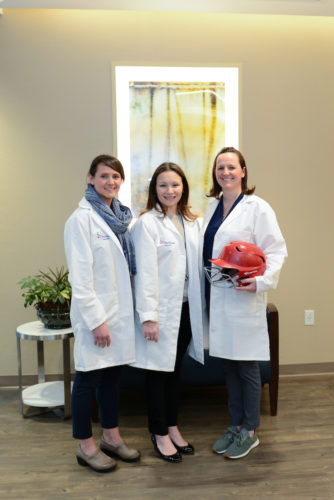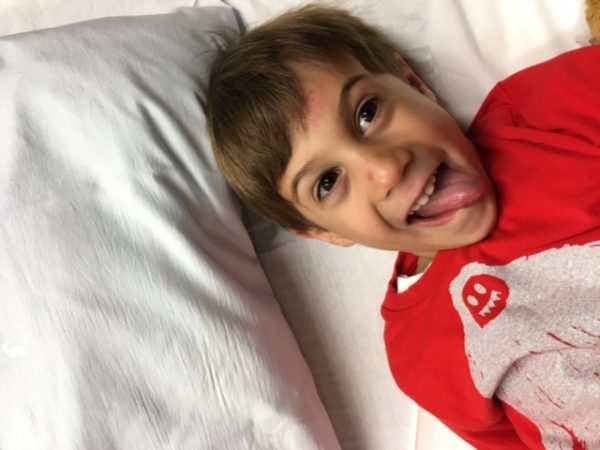
PHOTO BY CAROLYN SIMPSON, DOUBLEVSION PHOTOGRAPHERS
With the 53rd Super Bowl behind us and a spike in media coverage on NFL players and concussions, the 2017 season saw the highest rate of diagnosed concussions (291) in NFL players in a six-year period, according to the NFL and Quintiles, an independent third-party company. Although 2018 figures showed a 29 percent decrease in the number of concussions, it still remains a serious health problem for players.
Although NFL players may be at a higher risk for sustaining a concussion, which medical researchers refer to as a type of traumatic brain injury (TBI), they are not the only athletes experiencing concussions. Many high school athletes and younger ones are also suffering from concussions in our towns and the problem seems to be county-wide. In fact, in 2016 the former County Executive Rob Astorino formed the Westchester County Concussion Task Force to address the problem.
In observance of Brain Injury Awareness Month in March coinciding with the spring sports season kicking into high gear, Inside Press spoke with leading medical practitioners at Northern Westchester Hospital (NWH) to separate fact from fiction when it comes to concussion prevention, treatment and management.
Changing Perceptions About Concussions
When many people think of concussions, they think of an athlete on a football field who perhaps has lost consciousness. While losing consciousness can certainly be a symptom of concussion, there are a host of other concussion symptoms and they don’t necessarily present themselves at the time of injury. Concussions are a type of brain injury that results from a bump, blow or jolt to the head or by a hit to the body that causes the head and brain to move back and forth. This back and forth movement can cause the brain to bounce around in the skull which can result in stretching or damaging brain cells. Many health professionals classify concussion as a mild TBI (traumatic brain injury) because the injury is usually not life-threatening and in most cases, symptoms resolve on their own. However, some patients have lingering symptoms that require treatment from a specialist trained in concussion management.

Chari Hirshson, PhD is a neuropsychologist with NWH who specializes in brain injury and treats both adults and children (ages 8 and up) who have sustained a concussion. According to Dr. Hirshson, who sees her patients at the hospital’s Ambulatory Care Center at Chappaqua Crossing, “concussion symptoms vary from patient to patient,” she explains. “It is important to take a multi-disciplinary approach with patients that have lingering symptoms because their symptoms can be multifaceted, encompassing physical, emotional and cognitive realms,” adds Lisa Rusch, PT, DPT, GCS, a Supervisor in the Concussion Rehab Program at NWH.
Acknowledging that concussions can be diagnosed by urgent care specialists, pediatricians or in the ER, an MRI or CT scan rarely shows signs of concussion. “Most of the time, these tests come back normal. It is not like with an X-ray that shows a broken bone. This can make it difficult to gauge the severity of the injury,” says Dr. Hirshson.
Varying Symptoms
Patients with a concussion can experience observable signs such as:
- Appearing dazed and confused
- Forgetting instructions
- Moving clumsily
- Answering questions slowly
- Losing consciousness (even briefly)
- Showing mood, behavior or personality changes

Patients with a concussion may also report these symptoms:
- Headache or “pressure” in the head
- Nausea or vomiting
- Balance problems or dizziness/blurred vision
- Bothered by light or noise
- Feeling sluggish, hazy, foggy or groggy
- Confusion, concentration or memory problems
- “Feeling down,” irritable or anxious
- Changes in sleep patterns
Some patients do not exhibit any symptoms until a few hours or even a few days after the injury. That was the case with Ryan Esposito, an Armonk child who decided to take his scooter down the porch and ride it without a helmet and unsupervised when he was five years old. He fell down the stairs by his driveway and while his head was bruised and bloody, he did not exhibit any concussion symptoms that afternoon upon examination by a pediatrician. “The doctor did not want to give him an MRI because he was so young but told us to take him to the ER if he starts vomiting,” recalls his mother Faine Esposito. Sure enough, at midnight Ryan started vomiting and was taken to NWH and diagnosed with a concussion.
Falls: A Leading Cause of Concussion
Despite many people believing that contact sports are a leading cause of concussion in children, more than 55 percent, in children up to 14 years old, are actually due to falls like Ryan’s. Hirshson adds, many of her adult patients sustain their concussion as a result of falls which could have been easily prevented. “I’ve seen falls resulting in concussion from women wearing jeans that are too long, or men who are carrying messenger bags with a strap that is too long and they trip. These injuries are not related to football, or skiing. These are things that can happen in everyday life,” she says.
Nevertheless, sports-related concussions due to being struck by an object or person is the second-leading cause of concussion in youth, accounting for 24 percent of cases in children up to 14 years old. In addition, 71 percent of sports and recreation-related TBI emergency department visits are among patients 10-19 years old. According to 2017 statistics from the US Centers for Disease Control and Prevention (CDC), 15 percent of high school students have had one or more concussions and 6 percent experienced two or more as a result of either playing a sport or being physically active. The rates were higher among males and the more sports a child played the higher the prevalence of concussion. Even more troubling was the fact that 40 percent of high school athletes reported that their coach was unaware of their symptoms. The researchers also found that some high school athletes tried to hide their symptoms from their coaches so that they would not get reduced playing time.

Gender Disparities in High School Athletes and Concussion Prevalence
There also appears to be a gender disparity in terms of the prevalence of concussion when high school athletes of both genders are playing the same sport. Females are more likely to suffer from concussion when playing soccer, basketball and lacrosse. Some of the reasons may be due to proper safety equipment. Boys are required to wear helmets in lacrosse while girls are not. Lauren Dinhofer, a senior who plays varsity lacrosse at Horace Greeley High School feels that helmets for her teammates should not be mandatory. “The use of helmets for me gives off the idea that girls are more protected, so you can be more aggressive on the field. However, helmets for girls don’t really have adequate materials for protection. Unlike boy helmets, girl helmets are soft and won’t make a difference against a check to the head. They invite more contact instead of offering protection.” But Melissa Mykytiuk, an Armonk mother of three boys who played lacrosse and ice hockey fervently disagrees. “Why don’t girls who play lacrosse wear helmets? Those sticks and balls are hard. It’s crazy to me.”
The Road to Recovery: Part 1: Return to School
Many of the patients who visit Dr. Hirshson or Rusch have been referred by a physician or a pediatrician. With a comprehensive approach tailored so that each patient can return to school and/or play, the team in the Concussion Management Program at NWH offers physical therapy, speech therapy, occupational therapy and neuropsychology. A coordinated team with their colleague Sarah Todd, PT, DPT, CLT who is the manager of Outpatient Rehabilitation Program at the hospital’s Chappaqua Crossing site, demonstrates why specific training in concussion management and a multi-disciplinary approach to care is critical to successful treatment. They often find a patient will seek treatment for one symptom, for example balance disturbance, and upon evaluation and assessment, additional effects of the concussion, such as memory issues, are uncovered and able to be treated.
Dr. Hirshson specializes in neuropsychology. The neuropsychological tests she performs can last from 4-8 hours and are designed to assess a patient’s cognitive strengths and weaknesses. “Typically, we don’t do neuropsychological testing until three months post-injury if cognitive symptoms have lingered,” explains Dr. Hirshson. If necessary, Dr. Hirshson will help young students manage their symptoms post-concussion before that 3-month period and help them transition back to school. The rigorous demands of high school, college applications and entrance exams can be very taxing on a student with lingering concussion symptoms. In certain cases and upon Dr. Hirshson’s clinical observations, some students may require support from the school, and she will work with the district to advocate for this, if necessary.
It is really important for a student suffering from concussion to get what medical professionals call adequate “cognitive rest” because this helps the brain recover. For example, if a student has an important test coming up, studying for it uses a lot of brain power and instead of using that energy for the brain to recover, it gets depleted which can ultimately delay recovery. Dr. Hirshson assesses each student and makes recommendations for returning to school on an individual basis “Take your cues from your kids,” advises Mytkiuk. Each of her three sons had a different recovery time from their concussion. “It’s frustrating because you don’t have control over when your kid’s brain gets better.”
Dr. Hirshson always tells her patients, “Don’t do something that doesn’t feel good. Don’t look at a screen if it hurts your head. Slowly build up tolerance. If you got a concussion over the weekend skiing, then don’t play soccer on Tuesday. Allow yourself the proper time to recover.”
Road to Recovery: Part 2: Return to Play
While the priority for all students recovering from concussion is to get them to return to school, for high school athletes returning to the field is often a main goal of recovery. With more than 4,000 New York based students under 19 treated at hospitals for sports-related traumatic brain injuries, following a return to play protocol is very important. In 2013, all states were mandated to pass laws to address concussion management in school athletics.
NY state school nurses, certified athletic trainers, coaches, and physical education teachers are mandated to complete sports concussion management training every two years. In addition, in both the Byram Hills School District and the Chappaqua Central School District, high school athletes undergo IMPACT (Immediate Post Concussion Assessment & Cognitive Testing) pre-season for a baseline assessment and upon returning to the field. Not all New York State school districts conduct IMPACT testing. Before a student returns to play, they must have medical clearance from a physician permitting it.
While Dr. Hirshson helps students return to the classroom, Rusch and Todd help students return to athletic endeavors. They help students suffering from symptoms such as neck pain, vestibular (inner ear) dizziness or disorientation and provide therapy to help them strengthen their eyes or restore equilibrium in addition to several other modalities. Todd often works on improving the vestibular system which can affect balance. “We retrain and recalibrate the vestibular system with dynamic exercises such as hopping on one foot on a foam board,” explains Todd. “We are part of that return to play conversation with the athletic trainers. We ensure that the athlete takes on exercises with increasing intensity in a controlled setting and then we make recommendations regarding return to play,” notes Rusch. “Interestingly, the research is indicating that patients who sustain a concussion are three times more likely to sustain a lower extremity injury of the knee or lower leg,” adds Todd.
“Each specific discipline that is part of the Concussion Management Program uses measurement tools to identify symptoms, measure their severity and develop a plan to progress so that patients return back to school and/or the field,” sums up Todd. “Because each concussion and its symptoms are unique, see a medical professional with credentials in concussion management who understands all the nuances,” advises Dr. Hirshson.
Ryan like most concussion patients had his symptoms resolve quickly and is now a happy six-year old back to playing on scooters and riding bikes. “But he remembers the injury and tells all his friends to be careful and of course wear a helmet,” his mother adds.
Helpful Helmet Tips
While there is no such thing as a “concussion-proof helmet,” the CDC notes that a proper fitting helmet can protect from a serious brain injury. Todd, who herself is a triathlete says that “helmet manufacturers are studying the dynamics of concussion and improving their designs based on the research.” As the biking season gears up, the CDC recommends the following tips when purchasing a helmet. The CDC also offers sports-specific guidelines for helmets available on www.cdc.gov/headsup.
Start with the Right Size
- Bring the bike rider with you to assess fit.
- Measure the child’s head size.
- Sizes vary from brand to brand, so look at the helmet’s fit and sizing chart.
Get a Good Fit
- The helmet should fit snugly all around with no spaces between the foam and bike rider’s head.
- Ask your child how the helmet feels. A too tight helmet can cause headaches.
- Have your child wear the hairstyle they will be wearing to ride the bike. If a long-haired child cuts their hair short, adjust the helmet accordingly.
- The helmet should not rest too high or too low on the rider’s head.
- Make sure your child can see straight forward and side to side.
- The side straps should make a “V” shape under and slightly in front of the bike rider’s ears.
- Chin straps should be centered under the bike rider’s chin and fit snugly so that no more than one or two fingers fit between the chin and strap.
Take Care of the Helmet
- Check for damage. Do not use a cracked or broken helmet or one that is missing parts.
- Clean it only with warm water and mild detergent.
- Keep the helmet away from direct sunlight and do not store in a car.
- Do not decorate with stickers or paint as this could affect the helmets safety.
Look for Labels
-
- Have the date of the manufacture in case of a recall.
- Purchase a helmet that is US Consumer Product Safety Commission (CPSC) certified.
Replace the helmet if it is damaged and has been involved in a crash!
Source: CDC Heads Up campaign

